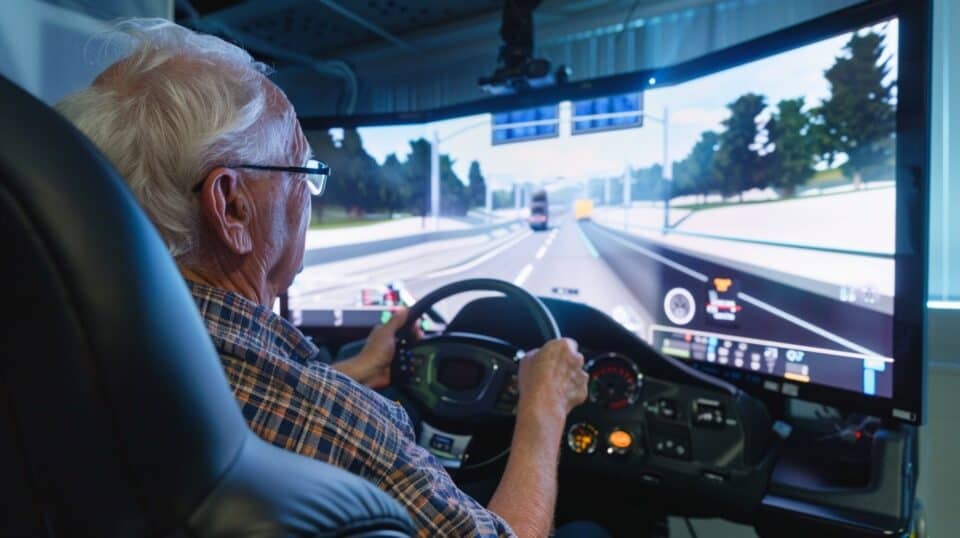Road safety demands immediate attention. Elderly drivers face unique challenges that impact everyone’s well-being. A study by the Insurance Institute for Highway Safety reveals that drivers aged 70 and older have higher crash rates per mile traveled than middle-aged drivers.
This statistic underscores the need for regular testing of older motorists to ensure they can operate vehicles safely. 1
As a certified traffic safety expert with 15 years of experience, I’ve seen firsthand how cognitive decline affects driving abilities. Regular assessments for elderly drivers are crucial to identify potential risks and maintain road safety.
This article explores 6 key reasons why testing older drivers is essential. You’ll learn how these evaluations protect both seniors and other road users. 2
Key Takeaways
Drivers aged 70 and older have higher crash rates per mile than middle-aged drivers, with 1,952 older adults dying in vehicle crashes in 2021.
Regular testing of elderly drivers helps identify age-related issues like slower reflexes, vision changes, and cognitive decline that can affect driving ability.
Pedal confusion incidents increase significantly after age 65, with drivers over 75 being four times more likely to experience this issue compared to younger drivers.
Many states have implemented specific guidelines for senior drivers, including shorter license renewal cycles, vision tests, and road tests for those 75 and older.
Advanced driver-assistance systems like automatic emergency braking and lane departure warnings can help compensate for slower reaction times in older drivers, potentially reducing accidents and extending driving years.
The Importance of Testing Elderly Drivers

Testing elderly drivers is key to keeping roads safe. It helps spot age-related issues that could lead to crashes.
Ensuring Road Safety for All
Road safety demands attention to elderly drivers. Crash data shows adults 65+ face higher risks of severe injuries and fatalities. 1 In 2021, 1,952 older adults died in vehicle crashes.
This sobering statistic highlights the need for comprehensive safety measures.
Safety innovations can help. Advanced driver-assistance systems like lane keeping and collision warnings benefit all drivers, especially seniors. Regular vision tests and driving evaluations ensure older adults maintain essential skills.
These steps, combined with education on age-related changes, create safer roads for everyone. Budget over 80s car insurance options can also encourage responsible driving among the eldest motorists. 2
Evaluating Cognitive Functions in Elders
Building on the importance of road safety, cognitive function evaluation in older drivers is crucial. Assessing mental abilities helps identify potential risks and ensures safer roads for everyone.
This process involves testing memory, attention, and decision-making skills essential for safe driving. 3
Cognitive screenings can detect mild impairments that affect driving performance. Nearly 60% of older adults with mild cognitive decline continue to drive, posing significant safety concerns. 2 With an expected increase to 15 million ADRD cases in the next 30 years, regular evaluations become even more critical. These assessments help maintain road safety while respecting seniors’ independence and mobility needs.
Identify Risks in Elderly Drivers

Aging can affect driving skills in ways that aren’t always obvious. Slower reflexes and vision changes might increase accident risk for older drivers.
Recognizing Decreased Reaction Capabilities
Aging drivers face a gradual decline in reaction times. This slowdown affects their ability to respond quickly to sudden road hazards or changes in traffic patterns. Studies show that drivers over 65 take up to 22% longer to react compared to younger adults.
Cognitive impairments, like mild dementia or Alzheimer’s, further amplify these delays. 2
Physical limitations also impact elderly drivers’ reactions. Reduced flexibility and strength can slow pedal transitions or steering wheel movements. Vision problems may hinder the quick recognition of road signs or obstacles.
These factors combine to increase the risk of accidents, especially in complex driving scenarios like busy intersections or highway merges.
Safe driving requires split-second decisions. As we age, our ability to make those decisions quickly diminishes. 4
Understanding Pedal Confusion Risks
Pedal confusion poses a serious threat to elderly drivers. This error occurs when a driver mistakenly presses the accelerator instead of the brake, often leading to sudden acceleration and potential accidents.
Older adults face a higher risk due to decreased cognitive functions and slower reaction times. Studies show that pedal confusion incidents increase significantly after age 65, with drivers over 75 being four times more likely to experience this issue compared to younger counterparts. 5
Safety experts recommend specific strategies to mitigate pedal confusion risks. These include adjusting seat position for optimal pedal reach, using one foot for both pedals, and practicing emergency braking in safe conditions.
Some car manufacturers now offer pedal misapplication prevention systems, which can detect unintended acceleration and automatically apply brakes. Regular vision and reflex tests for elderly drivers can also help identify those at higher risk of pedal confusion. 6
Advantages of Regular Retesting for Elderly Drivers

Regular retesting keeps elderly drivers informed about their current abilities. It also helps them stay up-to-date with new traffic laws and safety features.
Awareness of Personal Driving Limitations
Elderly drivers often develop a keen self-awareness of their driving limitations. Studies show 90% of older adults with dementia may pass a road test, yet many voluntarily choose not to renew their licenses as confidence wanes. 5 This self-regulation helps maintain road safety for all. Recognizing personal challenges – like slower reaction times or vision issues – allows seniors to make informed decisions about their driving capabilities.
Knowing your limits behind the wheel isn’t just smart – it’s a lifesaver.
Self-assessment tools and regular check-ups can help older drivers gauge their abilities. These evaluations might reveal the need for adaptive technologies in personal vehicles or rental cars.
By acknowledging limitations, seniors can explore alternative transportation options like ride-sharing services or public transit, ensuring continued mobility without compromising safety. 2
Compliance with Updated Road Regulations
Building on the awareness of personal driving limitations, staying current with road regulations is crucial for elderly drivers. Laws change, and new traffic rules emerge. Seniors should familiarize themselves with updated regulations to ensure safe driving practices.
This includes understanding new road signs, speed limits, and right-of-way rules.
Regular testing helps elderly drivers stay informed about these changes. It reinforces their knowledge of traffic laws and promotes safer driving habits. States vary in their requirements for license renewal among older drivers.
Some require more frequent vision tests or in-person renewals after a certain age. Complying with these regulations not only keeps seniors legal on the road but also contributes to overall road safety. 7
There are some solid reasons why elderly drivers should be tested. It increases road safety as those who are not safe are no longer licensed; seniors are more likely to get into an auto accident than other age groups.
Changes in vision and motor function can make driving more difficult as we age. 8
Supporting Elderly Drivers with Alternative Measures

Alternative transportation options can keep seniors mobile without driving. Smart home tech and delivery services help older adults stay independent at home.
Exploring Diverse Mobility Options
Seniors need safe, accessible transportation options beyond driving. Here are diverse mobility solutions for older adults:
- Ride-sharing services: Uber and Lyft offer convenient, on-demand transportation. Many provide wheelchair-accessible vehicles and special assistance for seniors.
- Public transit: Buses and trains often have discounted fares for seniors. Some cities offer free rides to older adults during off-peak hours.
- Paratransit services: Door-to-door transportation for seniors with disabilities who can’t use regular public transit. These services require advance booking.
- Senior shuttle programs: Many communities run free or low-cost shuttle services to take older adults to medical appointments, grocery stores, and social activities.
- Volunteer driver programs: Organizations like ITNAmerica connect seniors with volunteer drivers for rides to essential destinations.
- Walking and cycling: For short trips, walking or biking can be healthy options. Many cities are improving sidewalks and bike lanes for better accessibility. 9
- Electric bikes and scooters: These provide motorized assistance for longer trips while still offering exercise benefits. Some cities have e-bike sharing programs.
- Autonomous vehicles: Self-driving cars could revolutionize senior mobility in the future, allowing those with physical limitations to travel independently. 10
Implementing Advanced Safety Enhancements
Advanced safety enhancements offer crucial support for elderly drivers. These technologies aim to mitigate age-related declines and improve road safety for all. 10
- Adaptive Cruise Control: Maintains safe distances from other vehicles, reducing cognitive load for older drivers. 2
- Forward Collision Warning: Alerts drivers to potential front-end crashes, compensating for slower reaction times.
- Lane Departure Warnings: Helps prevent unintended lane drifting, a common issue for seniors with reduced peripheral vision.
- Automatic Emergency Braking: Applies brakes if a collision is imminent, crucial for those with slower reflexes.
- Blind Spot Detection: Notifies drivers of vehicles in hard-to-see areas, addressing limited neck mobility.
- Parking Assistance Systems: Aid in parallel parking and backing up, easing stress for those with reduced flexibility.
- Night Vision Enhancement: Improves visibility in low-light conditions, addressing age-related night vision decline.
- Voice-Activated Controls: Allow hands-free operation of various car functions, reducing distractions.
- Heads-Up Displays: Project important information onto the windshield, minimizing eye strain and cognitive overload.
- Smart Headlights: Adjust brightness and direction based on driving conditions, enhancing visibility for older eyes.
Implications for Driving Policies for the Elderly

Driving policies for older adults need an update. State and federal lawmakers must craft fair, safety-focused rules for senior drivers.
Developing State-Specific Driving Guidelines
State-specific driving guidelines for elderly drivers are crucial for addressing local needs and conditions. These guidelines aim to enhance road safety while respecting the independence of older drivers.
- Age-based testing: States implement vision and cognitive assessments for drivers over 65. Illinois requires road tests for drivers 75 and older every 4 years.
- Renewal periods: 18 states mandate shorter license renewal cycles for senior drivers. Florida requires 6-year renewals for drivers 80 and above, compared to 8 years for younger drivers. 4
- Medical reporting: Some states require physicians to report medical conditions that may impair driving. Pennsylvania mandates doctors to report patients with certain diagnoses to the Department of Motor Vehicles.
- Graduated de-licensing: Similar to teen drivers, some states adopt a step-down approach for seniors. Iowa restricts night driving for some older drivers based on vision test results.
- Education programs: States offer refresher courses for elderly drivers. AARP’s Driver Safety Program is recognized by 34 states for insurance discounts. 2
- Alternative transportation: Guidelines include developing senior-friendly public transit options. Vermont’s Elders and Persons with Disabilities Transportation Program offers rides to medical appointments and essential errands.
Discussing National Driving Standards
National driving standards for elderly drivers vary widely across the United States. These disparities highlight the need for a unified approach to ensure road safety and fair treatment of older motorists.
- Inconsistent age requirements: Some states mandate vision tests at 40, while others wait until 70 or have no age-specific rules. 2
- Renewal frequency gaps: Certain states require annual renewals for seniors, others maintain standard 4-8 year cycles for all ages.
- Medical evaluation discrepancies: A few states demand doctor’s clearance for older drivers, most rely on self-reporting of health issues. 2
- Cognitive testing variations: Select regions implement memory or reaction time assessments, many forgo mental acuity checks entirely. 4
- Road test policies: Several states require behind-the-wheel exams for senior license renewal, others skip practical evaluations.
- Vision screening differences: While all states check vision, the frequency and stringency of tests for older drivers fluctuate significantly.
- Educational requirements: Some jurisdictions mandate safety courses for senior drivers, others offer voluntary programs or none at all.
- Reporting mechanisms: Certain states allow family members or doctors to report unsafe elderly drivers, others lack formal processes.
Technological Innovations for Elderly Drivers

Tech upgrades make driving safer for older folks. Smart cars and helper gadgets give seniors more freedom on the road.
Integrating Advanced Driver-Assistance Systems
Advanced driver-assistance systems (ADAS) offer promising safety improvements for senior drivers. A recent study involving 18 drivers aged 70-79 tested ADAS-equipped vehicles for 6 weeks.
Participants reported feeling safer with these technologies, though they noted some limitations. ADAS features like automatic emergency braking and lane departure warnings can compensate for slower reaction times common in older drivers. 11
Integrating ADAS into vehicles driven by seniors could significantly reduce accidents and extend driving years. The technology assists with tasks that may become challenging with age, such as checking blind spots or maintaining proper following distance.
While seniors appreciated the added safety, more research is needed to optimize ADAS interfaces for older users and address concerns about over-reliance on automated systems. 12
Exploring Potential for Adaptive Driving Technologies
Adaptive driving technologies offer promising solutions for elderly drivers. GPS, cruise control, and rearview cameras top the list of commonly used Advanced Driver-Assistance Systems (ADAS) among seniors.
A study found that older adults with age-related macular degeneration utilized a median of 2.5 ADAS features. 13 These innovations aim to compensate for age-related changes in vision, reaction time, and cognitive function.
Efforts to boost trust in ADAS among older adults could increase adoption rates. Manufacturers are developing user-friendly interfaces and providing comprehensive training programs. 10 Some emerging technologies include voice-activated controls, heads-up displays, and automated emergency braking systems. These advancements help maintain independence and enhance safety for elderly drivers on the road.
People Also Ask
Why test elderly drivers?
Safety first! Aging affects driving skills. Tests catch issues early. They prevent road accidents and save lives.
How does aging impact driving?
It slows reactions. Vision and hearing worsen. Memory fades. These changes raise crash risks for older folks.
Are special tests for seniors discriminatory?
No. They’re about safety, not age bias. Tests help identify risks… protect everyone on the road.
What medical conditions affect senior driving?
Dementia, Alzheimer’s, and mild cognitive issues can impair judgment. Physical disabilities may slow responses. Tests spot these concerns.
How can we support elderly drivers who can’t pass tests?
Offer alternatives. Ride-sharing services help. So do community programs. They prevent isolation and maintain independence.
Do driving tests for seniors reduce accidents?
Yes. They lower traffic fatalities. AAA Foundation research shows this. It’s a win for road safety and public health.
References
^ https://www.ncbi.nlm.nih.gov/pmc/articles/PMC7730871/
^ https://www.ncbi.nlm.nih.gov/pmc/articles/PMC8752189/
^ https://www.ncbi.nlm.nih.gov/pmc/articles/PMC9566535/
^ https://www.nia.nih.gov/health/safety/safe-driving-older-adults (2022-12-20)
^ https://www.ncbi.nlm.nih.gov/pmc/articles/PMC5830885/
^ https://www.ncbi.nlm.nih.gov/pmc/articles/PMC9957144/
^ https://www.griswoldcare.com/blog/pros-and-cons-of-retesting-elderly-drivers/ (2023-06-22)
^ https://www.educationalwave.com/pros-and-cons-of-retesting-elderly-drivers/
^ https://www.racfoundation.org/wp-content/uploads/Supporting_older_driver_mobility_Gandolfi_January_2020.pdf
^ https://www.ncbi.nlm.nih.gov/pmc/articles/PMC7302428/
^ https://www.ncbi.nlm.nih.gov/pmc/articles/PMC8944390/



